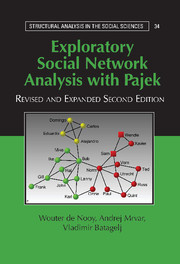Book contents
- Frontmatter
- Contents
- Figures
- Tables
- Preface to the Second Edition
- Preface to the First Edition
- Part I Fundamentals
- Part II Cohesion
- Part III Brokerage
- Part IV Ranking
- Part V Roles
- Appendix 1 Getting Started with Pajek
- Appendix 2 Exporting Visualizations
- Appendix 3 Shortcut Key Combinations
- Glossary
- Index of Pajek and R Commands
- Subject Index
Part V - Roles
Published online by Cambridge University Press: 05 June 2012
- Frontmatter
- Contents
- Figures
- Tables
- Preface to the Second Edition
- Preface to the First Edition
- Part I Fundamentals
- Part II Cohesion
- Part III Brokerage
- Part IV Ranking
- Part V Roles
- Appendix 1 Getting Started with Pajek
- Appendix 2 Exporting Visualizations
- Appendix 3 Shortcut Key Combinations
- Glossary
- Index of Pajek and R Commands
- Subject Index
Summary
In the final part, we shift our attention from purely exploratory description of network structure to modeling. Two types of modeling are presented: blockmodels (Chapter 12) and random graph models (Chapter 13).
Cohesion, brokerage, and ranking are connected to social roles: being a member of a group, being a mediator, or being a superior. Each of these roles is associated with a particular pattern of ties. A blockmodel describes the social roles and associated patterns of ties in the network at large. Blockmodels offer a different perspective on the concepts discussed in previous chapters.
Could the structure of our network be random? Network exploration yields values for structural properties of networks, such as cohesion, centrality, and ranking. We assume that the structural properties result from choices made by the people represented in the network – who to relate to, who to avoid – and that structural properties are consequential to their attitudes and behavior. The social causes and consequences of network structure give meaning to structural indices. Random graph models show us how confident we can be that network properties and effects result from social rather than random processes.
- Type
- Chapter
- Information
- Exploratory Social Network Analysis with Pajek , pp. 297 - 298Publisher: Cambridge University PressPrint publication year: 2011

